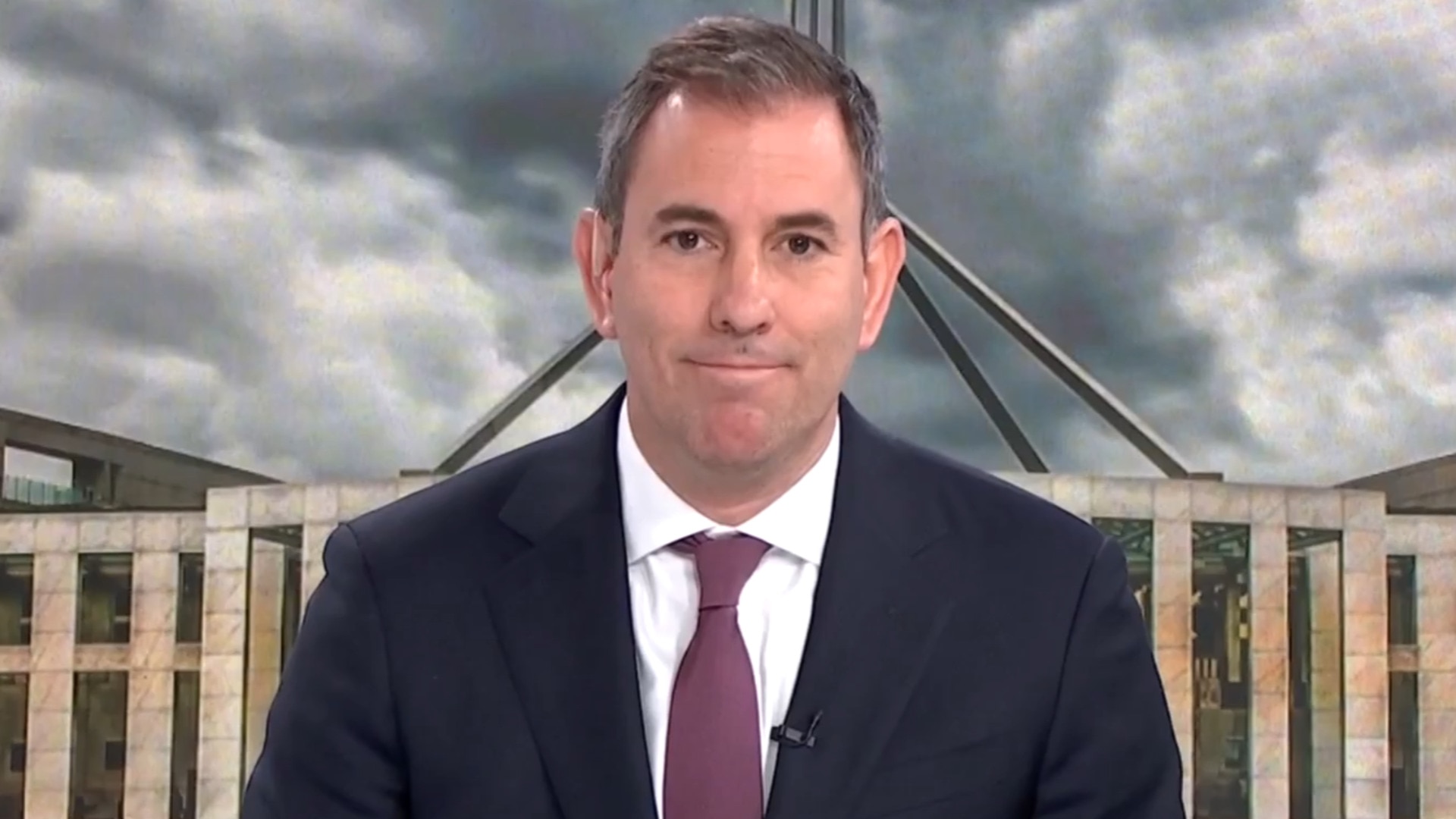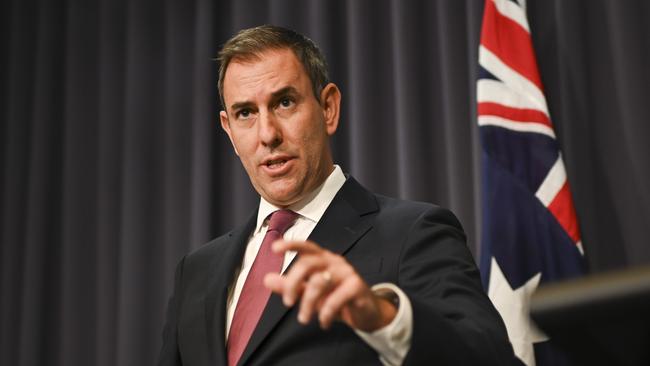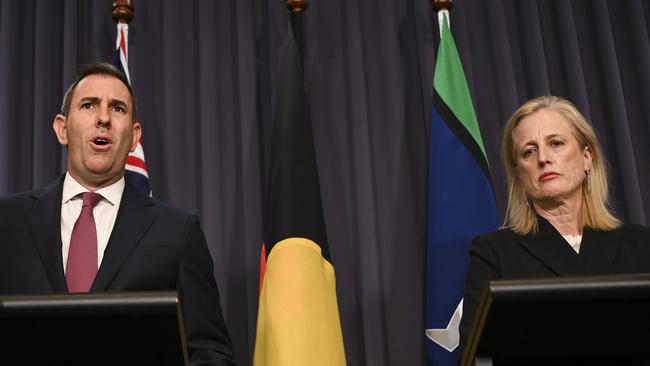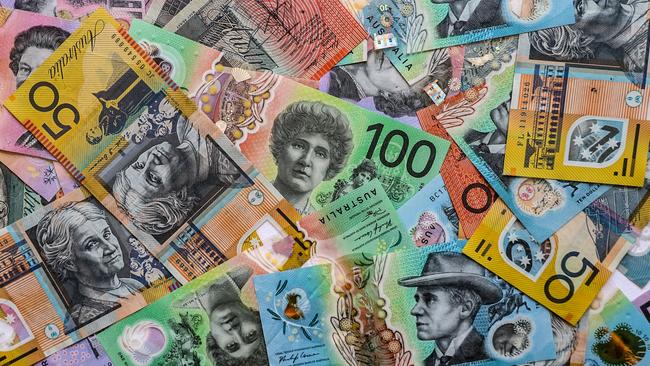‘Unavoidable’: Treasurer Jim Chalmers defends budget deficit after revealing astonishing $21.9bn deficit blowout
Australia’s bottom line is set to sink deeper into the red by $21bn over the next four years, with “unavoidable spending” and uncertain global outlook to blame.

Breaking News
Don't miss out on the headlines from Breaking News. Followed categories will be added to My News.
Budget deficits over the next four years are forecast to increase by $21.8bn to $143.9bn, with the budget blowout blamed on “unavoidable spending”.
While the budget bottom line has improved by $1.3bn this financial year, bringing the forecast deficit from $28.3bn to $26.9bn, the deficit forecast over 2025-26 will grow from $42.8bn to $46.9bn, or 1.6 per cent of Australia’s GDP, according to figures released in the Mid-Year Economic Fiscal Outlook (MYEFO).
This would be the largest deficit outside of the pandemic since 2015.
In 2026-27, the deficit is tipped to reduce to $38.4bn, and then $31.7bn in 2027-28, up from May estimates of $26.7bn and $24.3bn respectively.

The string of looming deficits follows back-to-back surpluses, with medium-term projections indicating the budget will not be back in black until 2034-35.
Despite the increased deficits, Jim Chalmers said the overall budget performance had improved by $27.1bn in the four years to 2027-28 compared to figures released in the final weeks of the Morrison government before the 2022 election.
Deficit increase blamed on ‘unavoidable spending’
The $21.8bn deficit blowout has been attributed to $8.8bn in “unavoidable spending” and $16.3bn in increases to government payments, like the age pension ($3.6bn), disability pension and payments ($3.6bn) and Job Seeker ($2.1bn) – with more people expected to be on income support over the next four years.
Payments to non-government schools are also forecast to grow by $2.1bn in the next four years, due to increasing enrolment numbers and schools increasing placements for students with disabilities “to attract a higher level of funding”.
An uncertain global outlook would continue to risk Australia’s economic stability, including increased “protectionism and strategic competition” between the US and China and its impact on trade.
There was also potential for a “sharp commodity price shock”.
China’s weakened economy will also continue to impact Australia’s export sector, particularly in key commodities like iron ore and copper.

Support mechanisms from the government are “unlikely to offer significant or ongoing support” for commodity prices.
They are not likely to “quickly restore demand” for Australian education and tourism services.
Dr Chalmers said despite the “slippage,” the government has improved the budget position by $200bn since pre-election figures.
He also said economic indicators were supporting that Australia was “on track” for a soft landing, with the cash rate tipped to ease “in the first half of 2025,” and decline to 3.6 per cent, from 4.35 per cent, by the middle of 2026.
“Even with a little bit of slippage and some of the years, a $200bn turnaround since we were elected is the biggest nominal consolidation in the budget on record and we have managed to get the deficit for this year a little bit smaller,” he said.

“We have made room for pressures and for priorities with all of the savings that we have made, $92bn of them, by banking revenue, by showing spending restraints.”
Finance Minister Katy Gallagher echoed Dr Chalmers’ comments.
“While the budget position is $1.3bn better off than forecast at budget, the slippage across the forward estimates is really down to emergence, unavoidable, automatic spending,” she said.
“Unavoidable spending is half of those decisions in MYEFO.”
Chalmers defends historic spending
Shadow Treasurer Angus Taylor criticised Labor’s budget for its mounting deficits and the “biggest spending government we have seen out of outside of wartime or crisis”.
“This is not free money. It doesn’t come from the sky. Australians have to pay that bill, and they pay it either through higher inflation, higher taxes and or higher interest rates,” he said.
Spending will steadily increase from 25.2 per cent GDP in 2024-25 to 26.5 per cent and 27.2 per cent in the years going forward – the highest outside of the Covid-19 pandemic since Australia was emerging from the 1980s downturn.
Dr Chalmers defended the spending and said the budget wasn’t “chock full of big, expensive, new decisions” but were based on the government “reconciling and accounting for (the) decisions we’ve taken,” or “unavoidable pressures”.

“We’ve done what’s necessary. We’ve accommodated pressures and priorities in the most responsible way that we can,” he said.
“I’d invite you to look through the spending, the new spending in the mid year budget update, and identify anything that any rational person would consider wasteful.”
The budget update also revealed about $5.5bn reserved for yet-to-be-announced policies ahead of a federal election.
However Dr Chalmers dashed speculation the funding had been earmarked for cost-of-living sweeteners.
“That is a relatively small number by his comparisons, particularly in the lead up to an election because decisions taken but not yet announced are a regular feature under both political persuasions and that is not an especially big number,” he said.
“From budget to budget, if we can afford to do more and there is a case to do more to help people be cost-of-living of course then we will consider that.”
Australia’s overseas net migration has also ballooned from May estimates of 260,000.
Updated figures from MYEFO documents reveal numbers are expected to hit 340,000, while forecasts for 2025-26 remain at 255,000.
Documents said while new arrivals were declining in line with budget expectations, less people than expected had left Australia in 2023-24.
“Departures are expected to pick up over 2024–25, albeit at a slower rate than anticipated at budget,” it said.
Originally published as ‘Unavoidable’: Treasurer Jim Chalmers defends budget deficit after revealing astonishing $21.9bn deficit blowout



